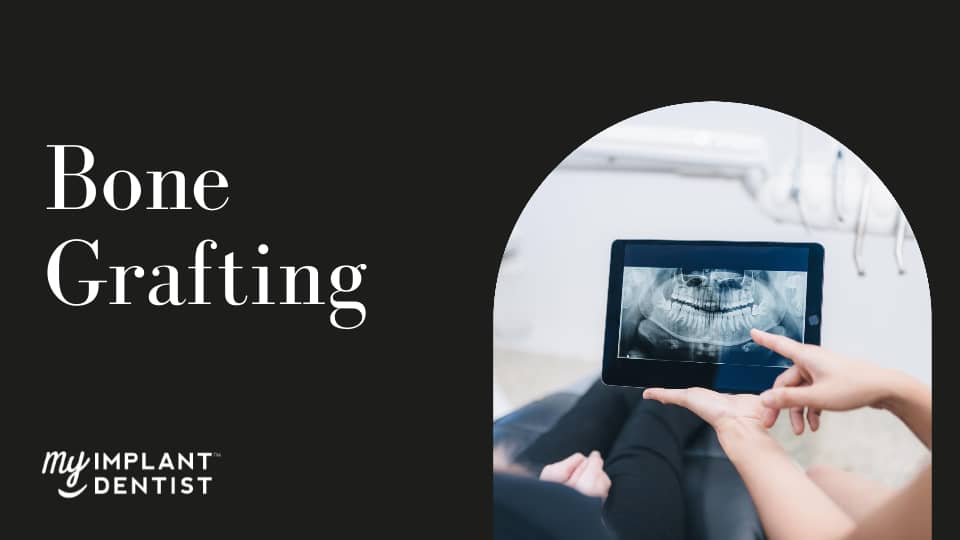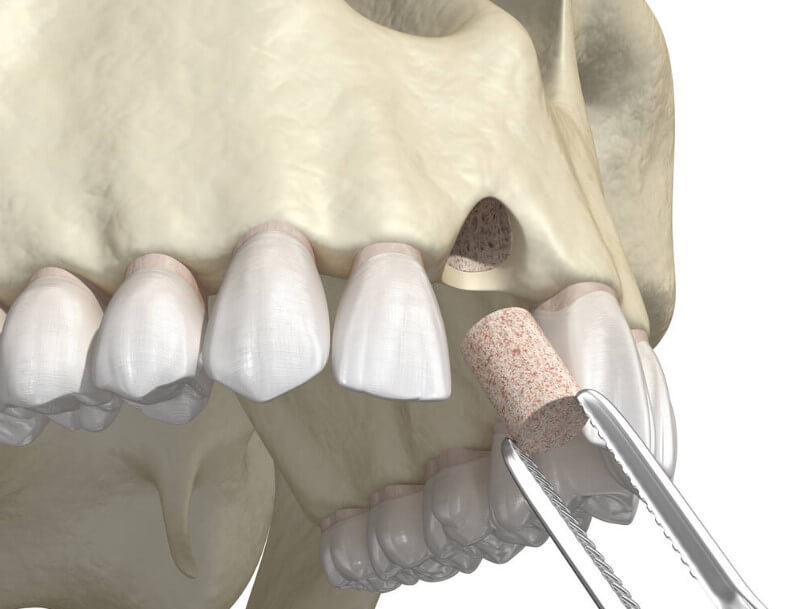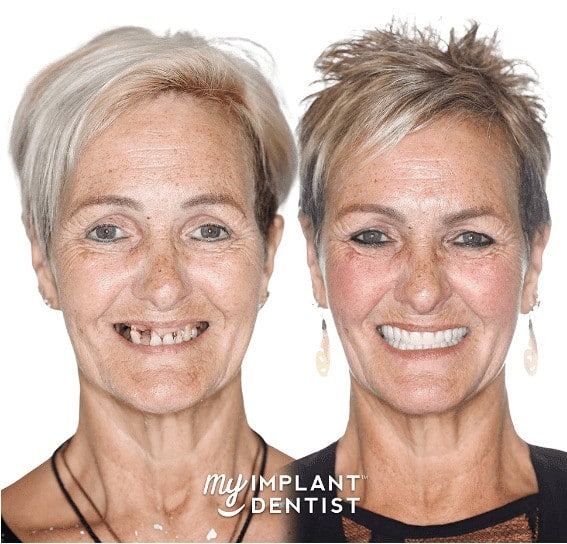
Contents
- 1 What is Bone Grafting?
- 2 What are the Benefits of Bone Grafting for Dental Implants?
- 3 When is Bone Grafting Necessary?
- 4 Types of Bone Grafts
- 5 Who Needs Bone Grafting?
- 6 How is Dental Bone Grafting Surgery Performed?
- 7 Pre and Post Bone Graft Procedures
- 8 How to Prepare for Bone Grafting
- 9 How Much Does Dental Bone Grafting Cost?
- 10 What are the Risks of a Bone Graft?
- 11 Is Bone Grafting Safe?
- 12 FAQs
The dental implant procedure calls for a healthy jawbone. However, not everyone has sturdy or suitable jawbones, so what happens then? A bone grafting procedure.
Bone grafting is a complementary procedure in implant dentistry because it helps prepare the bone for the implant. It involves using additional bone tissue to improve jawbone density and volume which has otherwise deteriorated due to trauma or damage.
In this article, we will guide you through the basic information surrounding bone grafting, its benefits, drawbacks, and what to expect.
- Bone grafting is a dental procedure used to improve jawbone density and volume.
- The procedure involves using bone tissue (graft material) to fill an incision in the gum and cover it with a membrane.
- Benefits of bone grafting include improved chances of successful implant placement, preservation of facial structure, improved oral health, and enhanced appearance.
- Bone grafting may be necessary in cases of dental implants, tooth loss or gum disease, or changes in facial structure.
- There are several types of bone grafts including allograft, autograft, xenograft, and synthetic bone graft.
- The likelihood of needing a bone graft increases with age, but it may be necessary for individuals of all ages depending on their oral health.
What is Bone Grafting?
Bone grafting is a surgical procedure that is used to fix problems associated with the bone or joints. It involves transplanting bone tissue; the transplanted bone can come from your own body, from a donor, or it can be synthetic. In the context of dental implants, bone grafting is used to increase the volume and density of the bone in your jaw.

What are the Benefits of Bone Grafting for Dental Implants?
Bone grafting for dental implants offers several advantages that contribute to the success and longevity of the implants. Here are some key benefits:
- Stability and Support: Bone grafting provides a solid and stable base for the dental implant, ensuring it stays securely in place. This is particularly important for the functionality and durability of the implant.
- Prevents Bone Loss: After tooth loss, the jawbone begins to deteriorate due to lack of stimulation. Bone grafting can help prevent this bone loss by stimulating new bone growth.
- Improves Success Rate: Bone grafting can significantly increase the success rate of dental implant surgery. By providing sufficient bone density, the implant can integrate better with the jawbone.
- Maintains Facial Structure: Bone loss in the jaw can lead to changes in facial structure, causing a sunken appearance. Bone grafting helps maintain the natural shape of the jaw and face.
- Improves Aesthetic Outcome: By preserving the jawbone and supporting facial structures, bone grafting can enhance the aesthetic outcome of dental implant surgery, leading to a more natural-looking smile.
- Allows for More Dental Implant Options: In cases where the jawbone is too thin or soft to support traditional implants, bone grafting can open up the possibility for more dental implant options.
When is Bone Grafting Necessary?
Bone grafting is often necessary in the following situations:
Dental Implants
Dental implants, typically made from titanium, need to be drilled into your jawbone as support for an artificial crown to replace a missing tooth. If your jawbone is not healthy, you will need to go through bone grafting procedures to prepare your jawbone and increase the implants’ likelihood of success.
Tooth Loss or Gum Disease
You may not need an implant, but a bone graft may be necessary if you’ve experienced tooth loss or gum disease. The effects of the disease and the missing tooth can negatively affect the health of your jawbone, so you may need to go through a bone grafting procedure for its revival.
Facial Structure
The degeneration of your jawbone can lead to a change in your facial appearance. This is because the jawbone supports the structure of your face. A bone graft will help revive the facial shape from your mouth to your cheeks.
Types of Bone Grafts
The types of bone grafts that exist depend on the source from which the bone tissues used as graft material are obtained.
Allograft Bone Graft
Allograft involves using another person’s bone tissue to strengthen your jawbone, usually from an anonymous donor.
Autograft Bone Graft
This is the preferred option as the graft material is extracted from your own body. The graft material may be taken from your hips, tibia, or the back of your jaw in the area of your wisdom teeth.
Xenograft Bone Graft
Here, the bone tissues (minerals) used in the surgery are extracted from other species such as cow, pig, or coral.
Synthetic Bone Graft
This grafting procedure involves using artificial graft material, just as the name implies. It typically uses materials such as calcium sodium phosphosilicate (Bioglass) or calcium phosphate.
Who Needs Bone Grafting?
Individuals who have experienced bone loss in their jaw due to tooth extraction, gum disease, or injury may require a bone graft. Additionally, those who have a naturally thin or soft jawbone may also need a bone graft to successfully receive dental implants.
How is Dental Bone Grafting Surgery Performed?
A dental bone grafting procedure is rather straightforward and doesn’t call for worry, as your dentist will explain everything to you. They will take X-rays or cone beam CT scans that enable them to create a personalised treatment plan tailored to your needs and budget.
- At the start of your surgery, your dentist will administer a local anaesthetic to ease you into comfort.
- Your dental technician will clean the area where the graft material will be placed.
- Your surgeon will make an incision in your gum to separate it from the area where the bone graft will be placed.
- Your surgeon will place the graft material into the area, cover it with a membrane, and stitch the incision closed.
- Your graft healing process is ready to begin.
Pre and Post Bone Graft Procedures
Bone grafting involves a series of steps before and after the procedure:
Bone Graft Before and After: What to Expect
Before a bone graft procedure, the dentist will conduct an oral examination and take X-rays, CT scans, or cone beam CT scans to assess bone density and location of nerves and sinuses. The procedure is usually performed under local anaesthesia. After the graft, some discomfort may be expected, which can be managed with over-the-counter pain medication.
Bone Grafting Surgery Recovery
Recovery time after a dental bone graft varies but is typically between 2 weeks and several months. It depends on the type of graft and the amount of bone loss. Patients should adhere to a soft-food diet and maintain oral hygiene to ensure a smooth recovery.
How to Prepare for Bone Grafting
You won’t have to go through an overly complicated preparation when considering how to prepare for bone grafting. Your dentist will inform you of any due preparations, but these are some of the common things you may need to check off:
- Make sure not to eat anything within 8–12 hours before your oral surgery.
- Check with your dentist for side effects caused by your medications, if any.
- Arrange for your transport to get back home as you may be groggy upon completing the procedure.
How Much Does Dental Bone Grafting Cost?
The cost of dental bone grafting can vary significantly based on several factors, including the type of graft used, the complexity of the procedure, and the specific dental surgeon’s fees. On average, you can expect to pay between AUD $3,000 and $8,000 per graft.
At My Implant Dentist, a highly qualified dentist will go through your consultation and propose a suitable treatment and payment plan for you.
What are the Risks of a Bone Graft?
As with any medical procedure, no dental procedure is 100% free of drawbacks. Bone graft procedures have a relatively high success rate with several benefits, but there are some risks associated with the procedure:
- Infection
- Bleeding
- Nerve damage
- Complications with anaesthesia
- Blood clots
- Rejection of the bone graft
Is Bone Grafting Safe?
Yes, bone grafting is generally considered safe. It’s a well-established procedure that has been used successfully for many years in dental surgery. As with any medical procedure, there are potential risks and complications, but these are rare. Your dental surgeon will discuss these with you in detail before the procedure.
FAQs
Is a Bone Graft Painful?
Your dentist will administer a sedative during the procedure so that you will feel no pain. However, you may experience mild pain after the procedure.
How Long Does a Bone Graft Take to Heal?
Depending on your treatment plan, a bone graft will take about 3–9 months to heal properly. But you may be back to feeling normal after 3 weeks.
How Successful is Bone Graft Surgery?
When performed by a qualified dentist or periodontist, bone graft surgery has relatively high success rates.
Which Bone is Used for Bone Grafting?
The bones used for dental bone grafting are usually taken from your hip, tibia, or the back of your jaw, in the wisdom tooth area.
What Does a Bone Graft Look Like?
A bone graft is made to look like your jawbone since it involves fusing bone tissue with it.




















